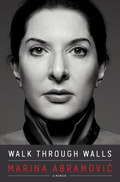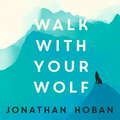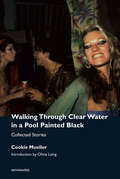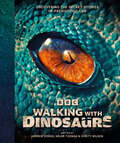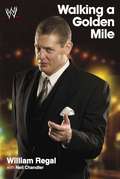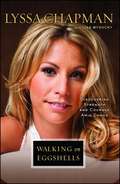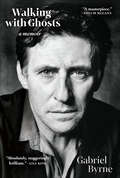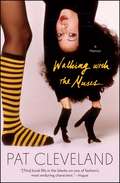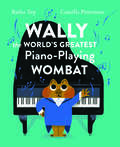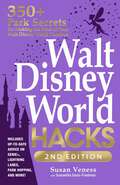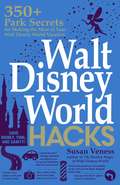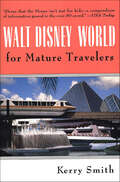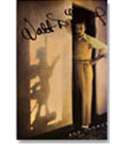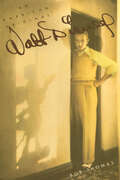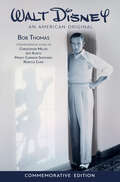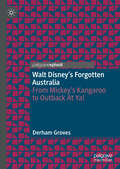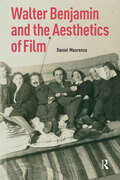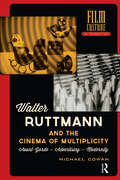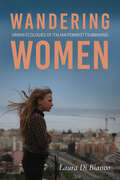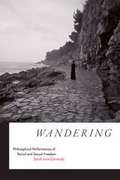- Table View
- List View
Walk Through Walls: A Memoir
by Marina Abramovic"I had experienced absolute freedom--I had felt that my body was without boundaries, limitless; that pain didn't matter, that nothing mattered at all--and it intoxicated me."In 2010, more than 750,000 people stood in line at Marina Abramović's MoMA retrospective for the chance to sit across from her and communicate with her nonverbally in an unprecedented durational performance that lasted more than 700 hours. This celebration of nearly fifty years of groundbreaking performance art demonstrated once again that Marina Abramović is truly a force of nature. The child of Communist war-hero parents under Tito's regime in postwar Yugoslavia, she was raised with a relentless work ethic. Even as she was beginning to build an international artistic career, Marina lived at home under her mother's abusive control, strictly obeying a 10 p.m. curfew. But nothing could quell her insatiable curiosity, her desire to connect with people, or her distinctly Balkan sense of humor--all of which informs her art and her life. The beating heart of Walk Through Walls is an operatic love story--a twelve-year collaboration with fellow performance artist Ulay, much of which was spent penniless in a van traveling across Europe--a relationship that began to unravel and came to a dramatic end atop the Great Wall of China. Marina's story, by turns moving, epic, and dryly funny, informs an incomparable artistic career that involves pushing her body past the limits of fear, pain, exhaustion, and danger in an uncompromising quest for emotional and spiritual transformation. A remarkable work of performance in its own right, Walk Through Walls is a vivid and powerful rendering of the unparalleled life of an extraordinary artist.From the Hardcover edition.
Walk Through Walls: A Memoir
by Marina Abramovic"I had experienced absolute freedom--I had felt that my body was without boundaries, limitless; that pain didn't matter, that nothing mattered at all--and it intoxicated me."In 2010, more than 750,000 people stood in line at Marina Abramović's MoMA retrospective for the chance to sit across from her and communicate with her nonverbally in an unprecedented durational performance that lasted more than 700 hours. This celebration of nearly fifty years of groundbreaking performance art demonstrated once again that Marina Abramović is truly a force of nature. The child of Communist war-hero parents under Tito's regime in postwar Yugoslavia, she was raised with a relentless work ethic. Even as she was beginning to build an international artistic career, Marina lived at home under her mother's abusive control, strictly obeying a 10 p.m. curfew. But nothing could quell her insatiable curiosity, her desire to connect with people, or her distinctly Balkan sense of humor--all of which informs her art and her life. The beating heart of Walk Through Walls is an operatic love story--a twelve-year collaboration with fellow performance artist Ulay, much of which was spent penniless in a van traveling across Europe--a relationship that began to unravel and came to a dramatic end atop the Great Wall of China. Marina's story, by turns moving, epic, and dryly funny, informs an incomparable artistic career that involves pushing her body past the limits of fear, pain, exhaustion, and danger in an uncompromising quest for emotional and spiritual transformation. A remarkable work of performance in its own right, Walk Through Walls is a vivid and powerful rendering of the unparalleled life of an extraordinary artist.From the Hardcover edition.
Walk With Your Wolf: Unlock your intuition, confidence & power with walking therapy
by Jonathan HobanNature is our greatest healer. It's time to start walking and reclaim the wildness in all of us.Walking is a way to get you to listen to yourself openly and honestly, without all the noise that our endless inner critic inflicts upon us.When did you last take a walk? Not a stroll to the shops, or to the pub, but a walk that got you energised, stimulated your senses, allowing you to de-stress? If the answer is that you'd love to walk, but don't have the time, there really are more reasons to get outside than you might think.When we walk we find the space to process our feelings and we begin to have the courage to be vulnerable and honest with ourselves. Walking awakens the intuition that helps us face up to our difficulties and walk alongside them, enabling us to find positive solutions to our problems. Our ancestors knew all about movement - they walked across the planet, understanding nature and learning to respect and work in harmony with it. Written by a London-based therapist, Walk with your Wolf is part memoir, part self-help and part reflection on the connection we must re-establish with our natural, intuitive selves if we are to live healthy, fulfilling lives. Offering practical advice and exercises on how to walk and think as a method of confronting difficult emotions, this book will allow you to reconnect with your intuition, confidence and power.(P)2019 Hodder & Stoughton Ltd
Walking Through Clear Water in a Pool Painted Black, new edition: Collected Stories (Semiotext(e) / Native Agents)
by Cookie MuellerThe first collected edition of legendary writer, actress, and adventurer Cookie Mueller's stories, featuring the entire contents of her 1990 book Walking through Clear Water in a Pool Painted Black, alongside more than two dozen others, some previously unpublished.Legendary as an underground actress, female adventurer, and East Village raconteur, Cookie Mueller's first calling was to the written word: "I started writing when I was six and have never stopped completely," she once confessed. Muellerís 1990 Walking through Clear Water in a Pool Painted Black, the first volume of the Semiotext(e) Native Agents series, was the largest collection of stories she compiled during her life. But it presented only a slice of Mueller's prolific work as a writer. This new, landmark volume collects all of Mueller's stories: from the original contents of Clear Water, to additional stories discovered by Amy Scholder for the posthumous anthology Ask Dr. Mueller, to selections from Mueller's art and advice columns for Details and the East Village Eye, to still "new" stories collected and published here for the first time. Olivia Laing's new introduction situates Mueller's writing within the context of her life—and our times. Thanks to recent documentaries like Mallory Curley's A Cookie Mueller Encyclopedia and Chloé Griffin's oral biography Edgewise, Mueller's life and work have been discovered by a new generation of readers. Walking through Clear Water in a Pool Painted Black: Collected Stories returns essential source material to these readers, the archive of Mueller's writing itself. Mueller's many mise en scènes—the Baltimore of John Waters, post-Stonewall Provincetown, avant-garde Italy, 1980s New York, an America enduring Reagan and AIDS—patches together a singular personal history and a primer for others. As Laing writes in her introduction, Collected Stories amounts to "a how-to manual for a life ricocheting joyously off the rails . . . a live corrective to conformity, conservatism, and cruelty."
Walking With Dinosaurs: Uncovering the Secret Stories of Prehistoric Life
by Andrew Cohen Helen Thomas Kirsty WilsonTravel back in time to the prehistoric world of the dinosaurs, brought to life in spectacular detail.Revisit the spectacle of the incredible new season of BBC One’s Walking With Dinosaurs in this richly detailed look into the distant past. With the latest up-to-date facts, interviews with leading dinosaur hunters, and insights from the TV series, this is the ultimate prehistoric book that every dinosaur enthusiast needs to own.Delve deeper into the dramatic stories of dinosaurs whose remains are currently being unearthed on dig sites all over the world. With stunning imagery and the latest scientific discoveries, these stories of legendary dinosaurs are waiting to be uncovered.A cutting-edge dinosaur book for a new generationBeautiful imagery and expert insights: Uncover the latest information as told by professional dinosaur hunters and paleontologists, which unfolds in the TV series’ signature narrative format and is accompanied by gorgeous imagery.Step into the breathtaking prehistoric world: Wade through prehistoric swamps, roam sprawling plains and discover primordial forests full of ancient life – home to some of our planet’s largest and most fascinating inhabitants.More than a companion book: Go beyond the Walking With Dinosaurs TV show by uncovering the backstories of each featured dinosaur, as told by the experts who brought the series to life.Walking With Dinosaurs’ first appearance in 1999 was the UK’s most-watched science program in the 20th century. Now 26 years later, it’s back – alongside this gorgeous book which continues the journey even beyond the documentary series.The hidden clues of the past have been painstakingly pieced together and compiled in this brilliant volume that dinosaur enthusiasts and natural history buffs will not want to miss.
Walking a Golden Mile
by William Regal Neil ChanlderThe bare-fisted brawler from Blackpool, England tells his story of fortune and fumbling on the road to the WWE's higher ranks.Since joining the WWE in 2000 as a goodwill ambassador from Great Britain, William Regal has established himself as an up-and-coming Superstar. He took the wrestling world by storm defeating many of the WWE's best wrestlers to win both the European and Intercontinental championships--although he's probably best known for getting back in WWE owner's Vince McMahon's good graces by kissing his naked backside on national television. While fans may still chuckle at Regal's humiliation, his in-ring success is no laughing matter. In this no-holds-barred look at his life, Regal for the first time talks about how he has dragged himself out of a life of poverty and adversity on the street of Blackpool, England and battled his own inner-demons to reach the top of the WWE's roster. He also discusses how he has overcome his recent life-threatening medical condition to return to triumphantly to the WWE.to admit when I know so many kids watch me on TV every week, but it's true. I detested it. My first school was a Catholic school, St Joseph's Convent, even though I'm not a Catholic. Mum leaving when I was so young didn't help matters, but I would never have been able to handle being preached at by those nuns in any case. I never liked being told that I'd go to hell if I didn't do what some nun told me to. Just about the only highlight I remember from school was being taken on a trip to Chester Zoo when I was eight. My best friend was a lad called Andrew who had this curly thick white hair. He began pulling faces at a gorilla who retaliated by throwing a big pile of shite at him, hitting him square in the face. All you could see of Andrew were his eyes, peering through this steaming mask. The nuns were running around, shouting and screaming. It was like a Tom and Jerry cartoon. If that was the only thing I can remember from school, you can imagine how mind-numbing I found the place. Then when I was nine I went to the middle school -- and was soon faced with another confusing situation. My mum had run off with this bloke and my dad ended up marrying his wife. It got pretty complicated. I've a half-brother who's my mum and step-dad's kid, and a step-sister. My dad had custody of me and I'd go to stay with my mum in the school holidays, but I didn't like going. She lived in Bristol, a hundred miles away. When I was there I never saw much of my brother, who was always out with his friends. I didn't really know him, though we do keep in touch today. He's nice enough. But most of the time I didn't want to be there because I wanted to stay at home with my dad, granddad and the close family who lived nearby: my uncles, aunties and cousins -- especially my cousin Graham. He's older than me, but we spent so much time together growing up that he's more like a brother to me than anything else. But my dad was always the one I looked up to. To this day he's the nicest man I've ever met -- and I'm not just saying that because he is my dad. He is the kindest person. I've never heard him swear or even say a bad word about anybody. He's a real hard worker, too. You never saw my dad without a pair of overalls on. He would come home covered in cement and has always worked hard for his living. He doesn't need to work these days but he still does. He still gets up early every morning and never stops all day. If he didn't work he wouldn't know what to do with himself. Lately he has had problems both with his leg and with his arm but nothing stops him. I've seen him shovelling stuff with one hand. If he gave it up now he'd have no financial worries but that is who he is -- a grafter. But what it meant for me when I was growing up was that dad was often out at work. That meant I spent a lot of time with his father, my granddad. Granddad's name was William Matthews, known as Bill, and he was probably the biggest influence in my life. In his younger days he was a bit of a rogue, well known for fighting and drinking. He'd do ...
Walking on Eggshells: Discovering Strength and Courage Amid Chaos
by Lyssa ChapmanAn empowering memoir that can inspire others to break the cycle of abuse and forge happiness out of extreme adversity.The ninth child of bounty hunter Duane Chapman, made famous on the A&E show Dog the Bounty Hunter, Lyssa Chapman has overcome an upbringing that can only be called tragic. In her piercing memoir, she shares the details of her harrowing childhood and her journey to faith, and offers compassionate guidance, advice, and hope to those who might feel overwhelmed in their own circumstances. As a child, Baby Lyssa&’s parents divorced and left her neglected. Things only got worse from there. Walking on Eggshells reveals Lyssa&’s nightmare passage from mental and physical abuse to removal from school and confinement at home, flight from protective services, and teen pregnancy. Despite it all, and against incredible odds, Lyssa found her faith. She also found her way out of the spiral of bad decisions to build a healthy relationship with her parents and forge a rewarding, positive life with God. An astonishing true story of one young woman&’s trek from poverty and abuse to fulfillment and stardom, Walking on Eggshells is heartrending, powerful, and inspiring.
Walking with Ghosts: A Memoir
by Gabriel Byrne&“A gripping memoir&” by the Irish actor &“that is anything but typical Hollywood . . . evokes a beautiful sense of nostalgia, melancholy and vulnerability&” (Winnipeg Free Press). As a young boy growing up in the outskirts of Dublin, Gabriel Byrne sought refuge in a world of imagination among the fields and hills near his home, at the edge of a rapidly encroaching city. Born to working class parents and the eldest of six children, he harbored a childhood desire to become a priest. When he was eleven years old, Byrne found himself crossing the Irish Sea to join a seminary in England. Four years later, Byrne had been expelled and he quickly returned to his native city. There he took odd jobs as a messenger boy and factory laborer to get by. In his spare time, he visited the cinema, where he could be alone and yet part of a crowd. It was here that he could begin to imagine a life beyond the grey world of 1960s Ireland. In this memoir he revels in the theater and poetry of Dublin&’s streets, populated by characters as eccentric and remarkable as any in fiction, and recounts his decision to join an amateur theater group—a decision that would change his life forever. Moving between sensual recollection of childhood in a now almost vanished Ireland and reflections on stardom in Hollywood and on Broadway, Byrne also courageously recounts his battle with addiction and the ambivalence of fame. &“[Byrne] writes with much more depth than the typical celebrity memoirist, accessing some of Heaney&’s earthiness and Joyce&’s grasp of how Catholic guilt can shape an artist. . . . a winning dry humor that reads as authentically humble.&” —Kirkus Reviews (starred review) &“A masterpiece . . . by turns poetic, moving, and very funny. You will find it on the shelf alongside other great Irish memoirs including those by Frank McCourt, Nuala O&’Faolain and Edna O&’Brien.&” —Colum McCann &“A real writer, a born storyteller.&” —The Washington Post &“A dreamy book . . . He writes passionately about his first love and hilariously about his early fame as an actor.&” —Irish Times
Walking with the Muses: A Memoir
by Pat ClevelandAn exciting account of the international adventures of fashion model Pat Cleveland--one of the first black supermodels during the wild sixties and seventies.New York in the sixties and seventies was glamorous and gritty at the same time, a place where people like Warhol, Avedon, and Halston as well their muses came to pursue their wildest ambitions, and when the well began to run dry they darted off to Paris. Though born on the very fringes of this world, Patricia Cleveland, through a combination of luck, incandescent beauty, and enviable style, soon found herself in the center of all that was creative, bohemian, and elegant. A "walking girl," a runway fashion model whose inimitable style still turns heads on the runways of New York, Paris, Milan, and Tokyo, Cleveland was in high demand. Ranging from the streets of New York to the jet-set beaches of Mexico, from the designer retailers of Paris to the offices of Diana Vreeland, here is Cleveland's larger-than-life story. One minute she's in a Harlem tenement making her own clothes and dreaming of something bigger, the next she's about to walk Halston's show alongside fellow model Anjelica Huston. One minute she's partying with Mick Jagger and Jack Nicholson, the next she's sharing the dance floor next to a man with stark white hair, an artist the world would later know as Warhol. One moment she's idolizing the silver screen sensation Warren Beatty, years later, she's deciding whether to resist his considerable amorous charms. In New York, she struggles to secure her first cover of a major magazine. In Paris, she's the toast of the town. And through the whirlwind of it all, she is forever in pursuit of love, truth, and beauty. A page-turning memoir of a life well lived, Walking with the Muses is a book you won't soon forget.
Walking with the Muses: A Memoir
by Pat ClevelandAn exciting account of the international adventures of fashion model Pat Cleveland--one of the first black supermodels during the wild sixties and seventies.New York in the sixties and seventies was glamorous and gritty at the same time, a place where people like Warhol, Avedon, and Halston as well their muses came to pursue their wildest ambitions, and when the well began to run dry they darted off to Paris. Though born on the very fringes of this world, Patricia Cleveland, through a combination of luck, incandescent beauty, and enviable style, soon found herself in the center of all that was creative, bohemian, and elegant. A "walking girl," a runway fashion model whose inimitable style still turns heads on the runways of New York, Paris, Milan, and Tokyo, Cleveland was in high demand. Ranging from the streets of New York to the jet-set beaches of Mexico, from the designer retailers of Paris to the offices of Diana Vreeland, here is Cleveland's larger-than-life story. One minute she's in a Harlem tenement making her own clothes and dreaming of something bigger, the next she's about to walk Halston's show alongside fellow model Anjelica Huston. One minute she's partying with Mick Jagger and Jack Nicholson, the next she's sharing the dance floor next to a man with stark white hair, an artist the world would later know as Warhol. One moment she's idolizing the silver screen sensation Warren Beatty, years later, she's deciding whether to resist his considerable amorous charms. In New York, she struggles to secure her first cover of a major magazine. In Paris, she's the toast of the town. And through the whirlwind of it all, she is forever in pursuit of love, truth, and beauty. A page-turning memoir of a life well lived, Walking with the Muses is a book you won't soon forget.
Wally the World's Greatest Piano-Playing Wombat
by Ratha TepWally was the world's greatest piano-playing wombat—until he realized there was an even more talented piano-playing wombat in town! This funny picture book's bright colors and imaginative musical scenes teach children to have self-confidence when faced with competition. When Wally, the world's greatest piano-playing wombat, hears Wylie play, he becomes envious. Wally tries toe-tapping and ball-twirling as he plays piano, but every time Wally thinks he's one-upping the competition, he discovers Wylie can do all the same tricks. Although Wally is discouraged at first, he soon realizes that competing with Wylie inspires them both to play better. And finding a friend to share what you love? That's the best win of all. Both affirming and motivating, Wally's story will resonate with young readers as they learn how to deal with competition and to do what makes them happy—even when they're not the very best.
Walt Disney World Hacks, 2nd Edition: 350+ Park Secrets for Making the Most of Your Walt Disney World Vacation (Disney Hidden Magic Gift Series)
by Susan Veness Samantha Davis-FriedmanHack your next Disney vacation to make the most magical place on earth the absolute happiest it can be with this updated guide to getting the most out of your visit.Did you know… -Some attractions inflate their wait time at the end of the day to discourage riders from entering the line when they&’re preparing to close? Check the rides in person...you might be able to cut your wait time in half since there might not actually be a long line! -Although pricier, Genie+ can sometimes come with extra &“freebies&”—if you know where to look? A great benefit is free digital downloads of select Disney PhotoPass attraction photos. -Packing something as simple as an extra pair of socks can really save your Disney day? Whether you&’re met with unexpected weather or are just tired from miles (literally!) of walking, switching out your socks halfway through the day can provide a much-needed refresh. Hack your next Disney vacation to experience as much Disney magic as possible! Walt Disney World has experienced a lot of changes in recent years—from the end of many iconic, beloved programs to updated attractions to price increases on everything from tickets to food and more. With this book in hand, you&’ll be prepared to handle every park change in stride, meet your favorite characters, and enjoy your favorite rides…while skipping the lines, the large price tags, and the stress. Utilize the new Genie+ program to the fullest, choose the Annual Passholder option that&’s best for you, and more! Walt Disney World Hacks, 2nd Edition will help you maximize your experience with up-to-date hacks on everything from Genie+ to new attractions, and more. With 350+ simple tricks, little-known facts, and helpful hacks, Walt Disney World Hacks, 2nd Edition will help you make sure your next Disney vacation is your happiest ever!
Walt Disney World Hacks: 350+ Park Secrets for Making the Most of Your Walt Disney World Vacation (Hidden Magic)
by Susan VenessMaximize the magic of the happiest place on earth with these 350+ tips on everything from improving your travel experience to getting the most out of each theme park to make your trip to Walt Disney World your best vacation ever. There’s adventure in every Disney story…now, experience your own adventure when you visit Walt Disney World! Let Walt Disney World Hacks show you how to meet your favorite characters, eat the best and most iconic food the park has to offer, and enjoy your favorite rides. With helpful and practical tips such as starting at the back of the park to avoid crowds, planning your visit for January or September for lower prices, and waiting at Hollywood Studios to meet characters you might not otherwise see, you’ll learn how to do Disney right—without spending the whole day in line, and without going over your budget!
Walt Disney World for Mature Travelers
by Kerry SmithAn irreverent yet authoritative guide to one of the world's most popular destinations, Kerry Smith's Walt Disney World for Mature Travelers (published in print in 1999) gives visitors the tools to make their own decisions and have the most enjoyable Disney vacation ever.Of the millions of visitors to Walt Disney World each year, more than 15% are 50 or older - a market segment that is booming. This guide is geared to the traveler who measures the success of a vacation by how much he or she enjoys it, not the need to see and do everything. Includes:* Food, lodging, rides and shows at the Magic Kingdom, Epcot Center, Disney-MGM Studios, Disney's Animal Kingdom, and other Disney attractions of interest to adults* Golf, tennis, and other sports at Disney resorts, Universal Studios and other tourist draws in the Orlando, Florida area* Special attention to issues of accessibility, varying levels of appeal to older travelers, layout, and convenience*Advice on approaching the parks differently with or without children and grandchildren**Note: Because this guide was originally published in 1999, some information may be outdated.**
Walt Disney's The Jungle Book: Making a Masterpiece
by Andreas Deja The Walt Disney Family MuseumWritten by Disney Legend Andreas Deja and lavishly illustrated, Walt Disney&’s The Jungle Book gathers original animation celluloids, animation drawings, and concept art—many of which have never been shown to the public—from the popular exhibition at The Walt Disney Family Museum in San Francisco. Considered one of the finest and most influential Disney movie, The Jungle Book (1967) is the last animated film that Walt Disney personally produced with his signature vision and footprint. This curated collection explores the nuanced complexities and challenges that were overcome throughout the film&’s development and production, such as the unique characters and their voice-actor counterparts, the application of cutting-edge animation techniques of the time, and the timeless, original songs by the Sherman Brothers and Terry Gilkyson. Dive into the impact of Walt&’s passing on the Disney Studios and the everlasting legacy of the film throughout the world. NEVER-BEFORE-SEEN ANIMATION: Includes original animation celluloids, animation drawings, and concept art from lead animators, most of which have never been seen by the public HEARTWARMING BEHIND-THE SCENES-STORIES: Learn how lead animators Ollie Johnston and Frank Thomas&’s real-life friendship became the inspiration for the on-screen chemistry between the characters Mowgli and Baloo EXPLORE THE HISTORY OF A BELOVED CLASSIC: Walt Disney&’s The Jungle Book narrates the complexities faced during the film&’s development and production as well as the use of new animation techniques at the time WRITTEN BY A DISNEY LEGEND: Andreas Deja, named a Disney Legend in 2015, has designed and overseen the animation of countless animated Disney films including The Little Mermaid, Aladdin, Beauty and the Beast, Hercules, and Lilo and Stitch PERFECT GIFT: Walt Disney&’s The Jungle Book is a must-have collectible gift for every Disney enthusiast and film historian in your life
Walt Disney: An American Original
by Bob ThomasA definitive biography of the man behind the legend. Walt Disney is an American hero--the creator of Mickey Mouse--and a man who changed the face of American culture. His is a success story like no other: a man who developed animated film into an art form and made a massive contribution to the folklore of the world.
Walt Disney: An American Original, Commemorative Edition (Disney Editions Deluxe)
by Bob ThomasThis is the Commemorative Edition of one of the most trusted and respected nonfiction books about Walt Disney ever written!Includes 4 commemorative essays; a photo insert with more than 60 behind-the-scenes images; and an endnotes section with insightful passages from 15 Disney historians and authors to provide further context for modern audiences.Walt Disney is an American hero. From Mickey Mouse to Disneyland, he changed the face of American culture. His is a success story like no other: a man who developed animated film into an art form and made a massive contribution to the folklore of the world.After years of research, respected Hollywood biographer Bob Thomas produced this definitive biography of the person behind the legend of Disney: the unschooled cartoonist from Kansas City, Missouri, who—though his initial studio went bankrupt during his first movie venture—developed into a creative spirit who produced unmatched works of entertainment that have influenced generations. Inside the Commemorative Edition paperback:• Special essays by Christopher Miller, Jeff Kurtti, Marcy Carriker Smothers, and Rebecca Cline and an updated index from the 2023 edition• Preface by Bob Thomas from the 1994 edition• Foreground, 28 chapters, and sources by Bob Thomas from the 1976 edition• Endnotes excerpting 15 books that have furthered Bob&’s research from the 2023 edition• 32-page photo insert with more than 60 behind-the-scenes images from the 2023 editionSearching for information about Walt Disney? Explore more books from Disney Editions:The Official Walt Disney Quote BookPeople Behind the Disney Parks: Stories of Those Honored with a Window on Main Street, U.S.A.Maps of the Disney Parks: Charting 60 Years from California to ShanghaiWalt's Disneyland: A Walk in the Park with Walt DisneyThe Story of Disney: 100 Years of Wonder
Walt Disney: an American Original, Commemorative Edition (Disney Editions Deluxe)
by Bob ThomasThis is the Commemorative Edition of one of the most trusted and respected nonfiction books about Walt Disney ever written!Includes 4 commemorative essays; a photo insert with more than 60 behind-the-scenes images; and an endnotes section with insightful passages from 15 Disney historians and authors to provide further context for modern audiences.Walt Disney is an American hero. From Mickey Mouse to Disneyland, he changed the face of American culture. His is a success story like no other: a man who developed animated film into an art form and made a massive contribution to the folklore of the world.After years of research, respected Hollywood biographer Bob Thomas produced this definitive biography of the person behind the legend of Disney: the unschooled cartoonist from Kansas City, Missouri, who—though his initial studio went bankrupt during his first movie venture—developed into a creative spirit who produced unmatched works of entertainment that have influenced generations. Inside the Commemorative Edition paperback:• Special essays by Christopher Miller, Jeff Kurtti, Marcy Carriker Smothers, and Rebecca Cline and an updated index from the 2023 edition• Preface by Bob Thomas from the 1994 edition• Foreground, 28 chapters, and sources by Bob Thomas from the 1976 edition• Endnotes excerpting 15 books that have furthered Bob&’s research from the 2023 edition• 32-page photo insert with more than 60 behind-the-scenes images from the 2023 editionSearching for information about Walt Disney? Explore more books from Disney Editions:The Official Walt Disney Quote BookPeople Behind the Disney Parks: Stories of Those Honored with a Window on Main Street, U.S.A.Maps of the Disney Parks: Charting 60 Years from California to ShanghaiWalt's Disneyland: A Walk in the Park with Walt DisneyThe Story of Disney: 100 Years of Wonder
Walt Disney’s Forgotten Australia: From Mickey’s Kangaroo to Outback At Ya!
by Derham GrovesThis book delves into the fascinating and often overlooked history of Walt Disney's influence in Australia, tracing the cultural impact of iconic characters like Mickey Mouse and Donald Duck from their inception in 1928 to the end of the Vietnam War. The author uncovers how Disney became intertwined with Australian popular culture, reflecting significant technological advancements and global events such as the introduction of radio and television, the Cold War, and more. The chapters investigate a range of topics, including Disney's dual role as a symbol of American culture and a mirror to Australian society. Readers will discover how Disney characters were perceived in Australia during pivotal moments in history, offering both entertainment and commentary on contemporary issues. The author provides expert analysis of Disney's complex legacy, examining both its positive contributions to Australian media and controversial aspects. This book invites readers to consider critical questions about cultural exchange and influence, making it a must-read for media and cultural history scholars looking to understand the intricate relationship between Disney and Australian culture, and indeed how global media can shape national identity and societal values. Whether you are a researcher in cultural studies or simply an enthusiast interested in Disney's global impact, this book provides a comprehensive look at an essential chapter in Australia's cultural narrative.
Walt before Mickey: Disney's Early Years, 1919-1928
by Timothy S. SusaninFor ten years before the creation of Mickey Mouse, Walt Disney struggled with, failed at, and eventually mastered the art and business of animation. Most biographies of his career begin in 1928, when Steamboat Willie was released. That first Disney Studio cartoon with synchronized sound made its main character—Mickey Mouse—an icon for generations. But Steamboat Willie was neither Disney's first cartoon nor Mickey Mouse's first appearance. Prior to this groundbreaking achievement, Walt Disney worked in a variety of venues and studios, refining what would become known as the Disney style. In Walt before Mickey: Disney's Early Years, 1919–1928, Timothy Susanin creates a portrait of the artist from age seventeen to the cusp of his international renown. After serving in the Red Cross in France after World War I, Walt Disney worked for advertising and commercial art in Kansas City. Walt used these experiences to create four studios—Kaycee Studios, Laugh-O-gram Films, Disney Brothers Studio, and Walt Disney Studio. Using company documents, private correspondence between Walt and his brother Roy, contemporary newspaper accounts, and new interviews with Disney's associates, Susanin traces Disney's path. The author shows Disney to be a complicated, resourceful man, especially during his early career. Walt before Mickey, a critical biography of a man at a crucial juncture, provides the “missing decade” that started Walt Disney's career and gave him the skills to become a name known worldwide.
Walter Benjamin and the Aesthetics of Film
by Daniel MourenzaWalter Benjamin is today regarded as one of the leading thinkers of the twentieth century. Often captured in pensive pose, his image is now that of a serious intellectual. But Benjamin was also a fan of the comedies of Adolphe Menjou, Mickey Mouse, and Charlie Chaplin. As an antidote to repressive civilization, he developed, through these figures, a theory of laughter. Walter Benjamin and the Aesthetics of Film is the first monograph to thoroughly analyse Benjamin’s film writings, contextualizing them within his oeuvre whilst also paying attention to the various films, actors, and directors that sparked his interest. The book situates all these writings within Benjamin’s ‘anthropological materialism’, a concept that analyses the transformations of the human sensorium through technology. Through the term ‘innervation’, Benjamin thought of film spectatorship as an empowering reception that, through a rush of energy, would form a collective body within the audience, interpenetrating a liberated technology into the distracted spectators. Benjamin’s writings on Soviet film and German cinema, Charlie Chaplin, and Mickey Mouse are analysed in relation to this posthuman constellation that Benjamin had started to dream of in the early twenties, long before he began to theorize about films.
Walter Ruttmann and the Cinema of Multiplicity: Avant-Garde Film - Advertising - Modernity (Film Culture in Transition)
by Michael CowanA key figure in early avant-garde cinema, Walter Ruttmann was a pioneer of experimental animation and the creative force behind one of the silent era's most celebrated montage films, Berlin: Symphony of a Great City. Yet even as he was making experimental films, Ruttmann had a day job. He worked regularly in advertising -and he would go on to make industrial films, medical films, and even Nazi propaganda films. Michael Cowan offers here the first study of Ruttmann in English, not only shedding light on his commercial, industrial, and propaganda work, but also rethinking his significance in light of recent transformations in film studies. Cowan brilliantly teases out the linkages between the avant-garde and industrial society in the early twentieth century, showing how Ruttmann's films incorporated and enacted strategies for managing the multiplicities of mass society. This book has won the Willy Haas Award 2014 for its outstanding contribution to the study of German cinema.
Waltz of the Snowflakes
by Elly MackayIt is a cold and rainy evening when Gran gives her granddaughter something special: tickets to the ballet. Her granddaughter is reluctant to go. The weather is terrible and they have to wear fancy, uncomfortable clothes. But as the curtains rise on The Nutcracker, the girl's eyes light up as she's introduced to the magic of the theater. The bright costumes, the intricate dances, the magical music, and a new friend all combine to captivate the girl and to bring color to an otherwise dreary evening.Waltz of the Snowflakes is Elly MacKay at her finest, mixing her acclaimed paper-cut artwork with vibrant colors in this whimsical, dreamlike, and inspiring wordless picture book. A must-have for any ballet- and theater-obsessed reader and the perfect gift to be shared during the holidays or any time of year when the world outside needs a little bit of color and vibrancy.
Wandering Women: Urban Ecologies of Italian Feminist Filmmaking (New Directions in National Cinemas)
by Laura Di BiancoWandering Women: Urban Ecologies of Italian Feminist Filmmaking explores the work of contemporary Italian women directors from feminist and ecological perspectives. Mostly relegated to the margins of the cultural scene, and concerned with women's marginality, the compelling films Wandering Women sheds light on tell stories of displacement and liminality that unfold through the act of walking in the city. The unusual emptiness of the cities that the nomadic female protagonists traverse highlights the absence of, and their wish for, life-sustaining communities. Laura Di Bianco contends that women's urban filmmaking—while articulating a claim for belonging and asserting cinematic and social agency—brings into view landscapes of the Anthropocene, where urban decay and the erasure of nature intersect with human alienation. Though a minor cinema, it is also a powerful movement of resistance against the dominant male narratives about the world we inhabit.Based on interviews with directors, Wandering Women deepens the understanding of contemporary Italian cinema while enriching the field of feminist ecocritical literature.
Wandering: Philosophical Performances of Racial and Sexual Freedom
by Sarah Jane CervenakCombining black feminist theory, philosophy, and performance studies, Sarah Jane Cervenak ruminates on the significance of physical and mental roaming for black freedom. She is particularly interested in the power of wandering or daydreaming for those whose mobility has been under severe constraint, from the slave era to the present. Since the Enlightenment, wandering has been considered dangerous and even criminal when associated with people of color. Cervenak engages artist-philosophers who focus on wayward movement and daydreaming, or mental travel, that transcend state-imposed limitations on physical, geographic movement. From Sojourner Truth's spiritual and physical roaming to the rambling protagonist of Gayl Jones's novel Mosquito, Cervenak highlights modes of wandering that subvert Enlightenment-based protocols of rationality, composure, and upstanding comportment. Turning to the artists Pope.L (William Pope.L), Adrian Piper, and Carrie Mae Weems, Cervenak argues that their work produces an otherworldly movement, an errant kinesis that exceeds locomotive constraints, resisting the straightening-out processes of post-Enlightenment, white-supremacist, capitalist, sexist, and heteronormative modernity. Their roaming animates another terrain, one where free, black movement is not necessarily connected to that which can be seen, touched, known, and materially valued.
